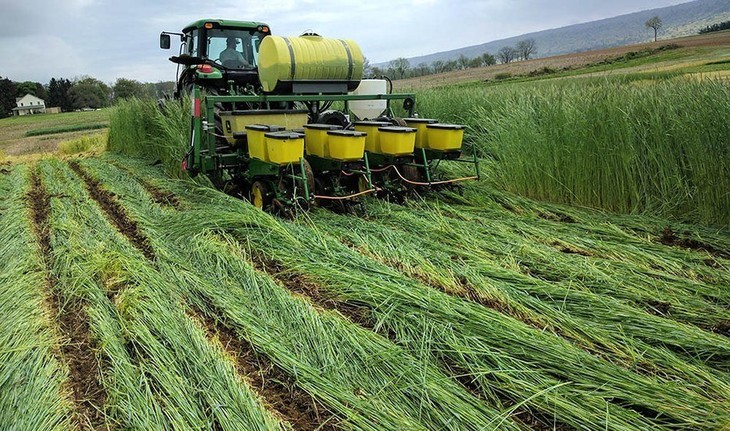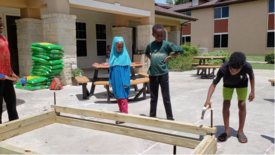|
Having trouble viewing this email? View it as a Web page.

|
|
|
Editor: Kelly Sprute July 10, 2019
Making a Difference
 Cereal rye is rolled and soybeans planted green in the same pass at Penn State's Russell E. Larson Agricultural Research Center. Photo by Heidi Reed Penn State.
‘Planting Green’ Cover-Crop Strategy May Help Farmers Deal with Wet Springs
Allowing cover crops to grow two weeks longer in the spring and planting corn and soybean crops into them before termination is a strategy that may help no-till farmers deal with wet springs, according to Penn State researchers.
The approach, known as planting green, could help no-till farmers counter a range of problems they must deal with during wet springs. These problems include soil erosion, nutrient losses, soils holding too much moisture and causing a delay in the planting of main crops, and main-crop damage from slugs. Read the full Penn State University article.
NIFA supported this research through the Agriculture and Food Research Initiative program.
|
|

NIFA’s 2018 Annual Report Now Online
NIFA’s 2018 Annual Report has been published. This year’s report highlights the exciting work undertaken by NIFA-funded grantees in the areas of research, education, and extension.
As our director, J. Scott Angle, notes in his introduction, “This annual report includes powerful examples of the many NIFA-funded research, extension, and education solutions that address societal challenges. I look forward to the transformative and remarkable discoveries that our grantees will make. Read the full NIFA 2018 Annual Report.
|

Drones Provide Eye-in-the-Sky to Help Fight Fires
Wildfires blackened nearly 8.8 million acres in the United States last year, highlighted in the news by California’s Camp Fire, the deadliest in that state’s history.
One of the many things that make wildfires so difficult to contain is the effect a fire has on local winds, which can move the fire in unexpected directions with virtually no notice. However, now, technology is being tested that may help firefighters keep pace with a blaze – increasing their safety and allowing them to better position their limited resources.
Xiaolin Hu, director of Georgia State University’s Systems Integrated Modeling and Simulation lab, is heading a project that develops drones to collect real-time data about wildfires, including fire front data and wind data in the wildfire area. Read the full USDA blog.
Camera view of a wildfire taken from a drone specially fitted to analyze fire and wind data. Photo courtesy of Xiaolin Hu.
|

4-H Agent Helping to Lead Change
Children find inspiration in many things. For the students of the Oak Manor 4-H Club of Bexar County, Texas, a small project blossomed into something greater with more meaning for their community. Cooperative Extension Program 4-H and Youth Development Agent Sayako Seymour led a garden project for students of Oak Manor 4-H Club to create a community garden. Read the full Prairie View A&M University article.
NIFA supported this through the 1890 Extension Formula Program.
Oak Manor 4-H Club member construct a garden box. Photo courtesy of Prairie View A&M University.
|

Nitrogen from Biosolids Can help Urban Soils and Plant Growth
The “zero waste” trend could have a friend in the form of biosolids. Biosolids are the materials produced after domestic waste is treated in urban wastewater systems. In the past, most of this solid material was transferred to landfills. But, processes developed over the past few decades can create “exceptional quality” biosolids.
These new “EQ” biosolids are low in pollutants and pathogens, but high in nutrients. They can be applied to agricultural or urban soils needing fertilizer and other soil health improvements. That reuses a former “waste” material – and helps the environment along the way.
Biosolids are valuable because they are rich in nitrogen, a key nutrient for plants. But, only a fraction of the nitrogen in biosolids used as fertilizer becomes available to plants. This fraction is called bioavailable nitrogen. Read the full News Wise article.
NIFA provided funding through the Hatch Program. This research was recently published in the Soil Science Society of America Journal.
Biosolids compost (left) shows the presence of woody material mixed in during the composting process. Bloom biosolids product (right) shows the product’s dry, crumbly texture. Photo courtesy of Odiney Alvarez-Campos.
|

Notice of Intent to Request Approval To Renew an Information Collection and Record Keeping Requirement
A Federal Register on July 8 published a notice entitled "Notice of Intent to Request Approval To Renew an Information Collection and Record Keeping Requirement.”
In accordance with the Paperwork Reduction Act of 1995 and Office of Management and Budget regulations that implement the Paperwork Reduction Act of 1995, this notice announces NIFA’s intention to request approval to renew an information collection and record keeping requirement for the Veterinary Medical Loan Repayment Program.
Written comments on this notice must be received by Sept. 6, 2019, to be assured of consideration. Read the full Federal Register notice.
|
Capacity Building Grants for Non-Land-Grant Colleges of Agriculture Program
The Capacity Building Grants for Non-Land-Grant Colleges of Agriculture program (NLGCA) allows Non-Land-Grant institutions with schools of agriculture to receive NIFA funding. NLGCA allows institutes to carry out educational, research, and outreach activities that address priority concerns of national, regional, state, and local interest. This funding can be used to promote food security, food safety and improve production agriculture. Institutes can use the funding to develop curricula and enhance agricultural related programs. Read the full NLGCA request for applications.
|
|
|
NIFA’s mission is to invest in and advance agricultural
research, education, and extension that solve societal challenges. NIFA’s
investments in transformative science directly support the long-term prosperity
and global preeminence of U.S. agriculture. Keep informed about NIFA, USDA,
our land-grant and non-land-grant universities, and stakeholders with the NIFA
Update. Read past issues online,
sign up for email
updates or follow us on Twitter @USDA_NIFA, #NIFAImpacts.
If you wish to submit a news item or information, send an
email to NIFAUpdate.
USDA is an equal opportunity lender, provider, and
employer.
|
|